-
 bitcoin
bitcoin $122090.672462 USD
1.59% -
 ethereum
ethereum $4493.758974 USD
0.56% -
 xrp
xrp $3.033145 USD
0.65% -
 tether
tether $1.000629 USD
0.00% -
 bnb
bnb $1169.854250 USD
7.07% -
 solana
solana $230.954786 USD
-0.19% -
 usd-coin
usd-coin $0.999785 USD
0.00% -
 dogecoin
dogecoin $0.256108 USD
-1.12% -
 tron
tron $0.342333 USD
-0.12% -
 cardano
cardano $0.859632 USD
-0.10% -
 hyperliquid
hyperliquid $48.932146 USD
-2.25% -
 chainlink
chainlink $22.345466 USD
-1.29% -
 ethena-usde
ethena-usde $1.000217 USD
-0.03% -
 avalanche
avalanche $31.203456 USD
1.93% -
 sui
sui $3.579145 USD
1.05%
What is a decentralized identity (DID) in DeFi?
Decentralized Identifiers (DIDs) empower DeFi users with self-sovereign digital identity management, enhancing privacy and security by eliminating reliance on centralized authorities, though scalability and user experience remain challenges to widespread adoption.
Mar 23, 2025 at 11:57 am
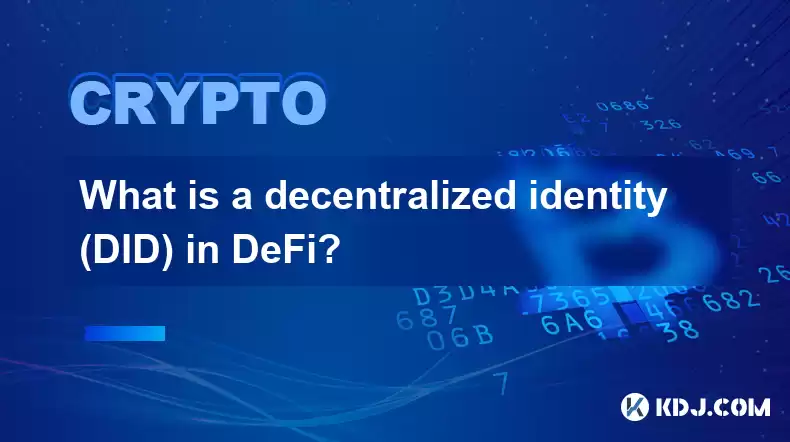
- Decentralized Identifiers (DIDs) offer a self-sovereign approach to digital identity management, crucial for DeFi's privacy and security needs.
- DIDs operate independently of centralized authorities, empowering users with control over their data.
- Integrating DIDs into DeFi applications enhances user privacy, reduces reliance on intermediaries, and streamlines various processes.
- Several challenges remain, including scalability, interoperability, and user experience, hindering widespread DID adoption in DeFi.
- Understanding different DID methods and their implementation within DeFi protocols is key to appreciating their potential.
Decentralized finance (DeFi) thrives on trustless interactions, but it currently relies heavily on centralized identity providers. This creates vulnerabilities and privacy concerns. Decentralized Identifiers (DIDs) offer a solution by enabling users to manage their digital identities independently, without relying on a central authority. This self-sovereign identity model aligns perfectly with the core principles of DeFi. Essentially, a DID is a verifiable identifier that users own and control.
How do DIDs work in DeFi?DIDs leverage cryptographic techniques to verify user identities. Instead of relying on a central database, a user's identity information is distributed across a decentralized network. This information can include various attributes, such as ownership of specific crypto assets or participation in DeFi protocols. This data is cryptographically secured, enhancing its integrity and preventing unauthorized access. Verification is achieved through cryptographic signatures and verifiable credentials.
What are the benefits of using DIDs in DeFi?The integration of DIDs in DeFi offers numerous advantages. Firstly, it significantly improves user privacy. Users maintain control over what data they share and with whom, reducing the risk of data breaches and unauthorized access. Secondly, it streamlines various DeFi processes. For instance, KYC/AML checks can be automated and verified using DIDs, reducing friction and improving efficiency. Thirdly, DIDs enhance security by eliminating single points of failure associated with centralized identity providers.
How are DIDs implemented in DeFi applications?The implementation of DIDs varies across different DeFi platforms. Some projects utilize existing blockchain technologies to store and manage DID data. Others leverage dedicated decentralized identity solutions. The process generally involves creating a DID, registering it on a blockchain, and then using verifiable credentials to prove identity for various DeFi applications. This could involve connecting a DID to a DeFi wallet, enabling seamless access to various decentralized services.
What are the different types of DIDs used in DeFi?Several different DID methods exist. Some rely on specific blockchain networks, while others utilize distributed ledger technologies or independent systems. Each approach has its own advantages and disadvantages in terms of scalability, security, and interoperability. The choice of DID method often depends on the specific requirements of the DeFi application. For example, some DIDs may be better suited for high-throughput applications, while others prioritize strong privacy guarantees.
What are the challenges of using DIDs in DeFi?Despite their potential, DIDs face several challenges in the DeFi space. Scalability remains a significant concern, as managing a large number of DIDs on a decentralized network can be computationally intensive. Interoperability is another issue; different DID methods may not be compatible with each other, hindering seamless data exchange between various DeFi applications. Finally, improving user experience is crucial for widespread adoption. The technical complexities of managing DIDs can be daunting for average users.
Step-by-step guide on creating and using a DID in a hypothetical DeFi scenario:- Choose a DID method: Select a DID method compatible with the DeFi platform you're using. Consider factors like scalability and privacy.
- Create a DID: Use the chosen method's tools or SDK to generate your unique DID. This often involves generating cryptographic keys.
- Register your DID: Register your DID on a suitable blockchain or decentralized ledger. This process varies depending on the chosen method.
- Create verifiable credentials: Generate verifiable credentials showcasing aspects of your identity relevant to DeFi interactions, like asset ownership.
- Use your DID and credentials: Use your DID and verifiable credentials to access DeFi services, such as lending, borrowing, or participating in decentralized exchanges.
Q: Are DIDs truly decentralized? A: While DIDs aim for decentralization, the underlying infrastructure (e.g., the blockchain or distributed ledger) can still influence the level of decentralization. Some implementations may rely on more centralized components than others.
Q: How secure are DIDs? A: The security of a DID depends on the cryptographic techniques used and the implementation of the system. Strong cryptography and proper key management are crucial for ensuring security.
Q: What is the difference between a DID and a traditional digital identity? A: Traditional digital identities are managed by centralized authorities, giving them control over your data. DIDs are self-sovereign, putting you in control.
Q: Will DIDs replace traditional KYC/AML processes? A: DIDs can streamline KYC/AML, automating verification and reducing reliance on intermediaries. However, they may not entirely replace these processes, especially regarding regulatory compliance.
Q: How can I learn more about DIDs and their use in DeFi? A: Numerous resources are available online, including research papers, technical documentation from various DID projects, and community forums dedicated to decentralized identity. Exploring the websites and documentation of specific DID methods is also helpful.
Disclaimer:info@kdj.com
The information provided is not trading advice. kdj.com does not assume any responsibility for any investments made based on the information provided in this article. Cryptocurrencies are highly volatile and it is highly recommended that you invest with caution after thorough research!
If you believe that the content used on this website infringes your copyright, please contact us immediately (info@kdj.com) and we will delete it promptly.
- BlockDAG, DOGE, HYPE Sponsorship: Crypto Trends Shaping 2025
- 2025-10-01 00:25:13
- Deutsche Börse and Circle: A StableCoin Adoption Powerhouse in Europe
- 2025-10-01 00:25:13
- BlockDAG's Presale Buzz: Is It the Crypto to Watch in October 2025?
- 2025-10-01 00:30:13
- Bitcoin, Crypto, and IQ: When Genius Meets Digital Gold?
- 2025-10-01 00:30:13
- Stablecoins, American Innovation, and Wallet Tokens: The Next Frontier
- 2025-10-01 00:35:12
- NBU, Coins, and Crypto in Ukraine: A New Yorker's Take
- 2025-10-01 00:45:14
Related knowledge

How to track DeFi activity on a block explorer
Sep 04,2025 at 05:36pm
Bitcoin's Role in Decentralized Finance1. Bitcoin remains the cornerstone of the cryptocurrency ecosystem, serving as both a store of value and a benc...
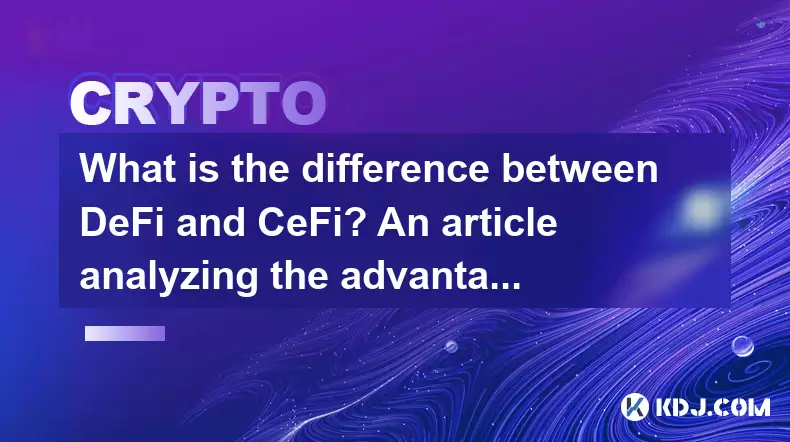
What is the difference between DeFi and CeFi? An article analyzing the advantages and disadvantages of both
Jun 13,2025 at 03:57am
Understanding the Foundations of DeFi and CeFiTo fully grasp the difference between DeFi (Decentralized Finance) and CeFi (Centralized Finance), it’s ...
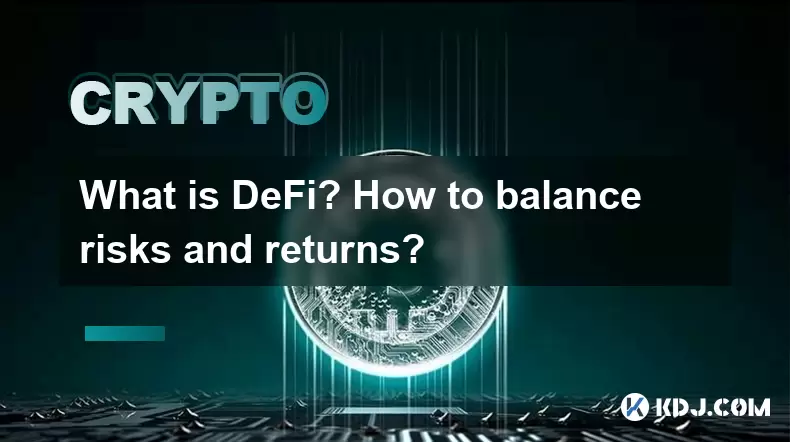
What is DeFi? How to balance risks and returns?
May 31,2025 at 12:22pm
What is DeFi? How to Balance Risks and Returns? Decentralized Finance, commonly known as DeFi, represents a revolutionary shift in the financial ecosy...
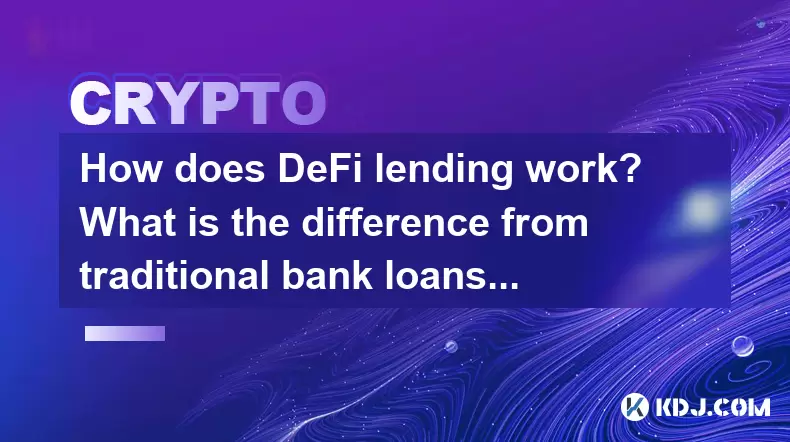
How does DeFi lending work? What is the difference from traditional bank loans?
May 29,2025 at 05:36pm
Introduction to DeFi LendingDeFi lending, or decentralized finance lending, represents a revolutionary shift in the way borrowing and lending are cond...
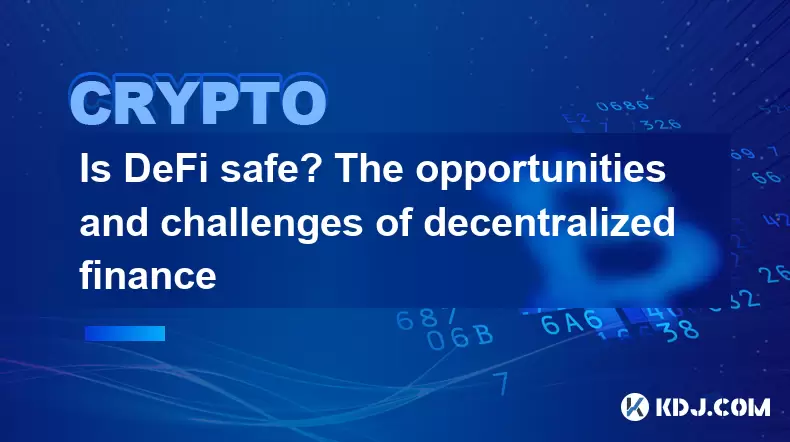
Is DeFi safe? The opportunities and challenges of decentralized finance
May 27,2025 at 02:28pm
Decentralized Finance, commonly known as DeFi, has revolutionized the financial landscape by offering a range of financial services without the need f...

DeFi Mining Tutorial: How to Maximize Profits and Reduce Risks?
May 27,2025 at 07:42am
DeFi, or Decentralized Finance, has opened up a new world of opportunities for crypto enthusiasts looking to maximize their profits through various mi...

How to track DeFi activity on a block explorer
Sep 04,2025 at 05:36pm
Bitcoin's Role in Decentralized Finance1. Bitcoin remains the cornerstone of the cryptocurrency ecosystem, serving as both a store of value and a benc...

What is the difference between DeFi and CeFi? An article analyzing the advantages and disadvantages of both
Jun 13,2025 at 03:57am
Understanding the Foundations of DeFi and CeFiTo fully grasp the difference between DeFi (Decentralized Finance) and CeFi (Centralized Finance), it’s ...

What is DeFi? How to balance risks and returns?
May 31,2025 at 12:22pm
What is DeFi? How to Balance Risks and Returns? Decentralized Finance, commonly known as DeFi, represents a revolutionary shift in the financial ecosy...

How does DeFi lending work? What is the difference from traditional bank loans?
May 29,2025 at 05:36pm
Introduction to DeFi LendingDeFi lending, or decentralized finance lending, represents a revolutionary shift in the way borrowing and lending are cond...

Is DeFi safe? The opportunities and challenges of decentralized finance
May 27,2025 at 02:28pm
Decentralized Finance, commonly known as DeFi, has revolutionized the financial landscape by offering a range of financial services without the need f...

DeFi Mining Tutorial: How to Maximize Profits and Reduce Risks?
May 27,2025 at 07:42am
DeFi, or Decentralized Finance, has opened up a new world of opportunities for crypto enthusiasts looking to maximize their profits through various mi...
See all articles










































































